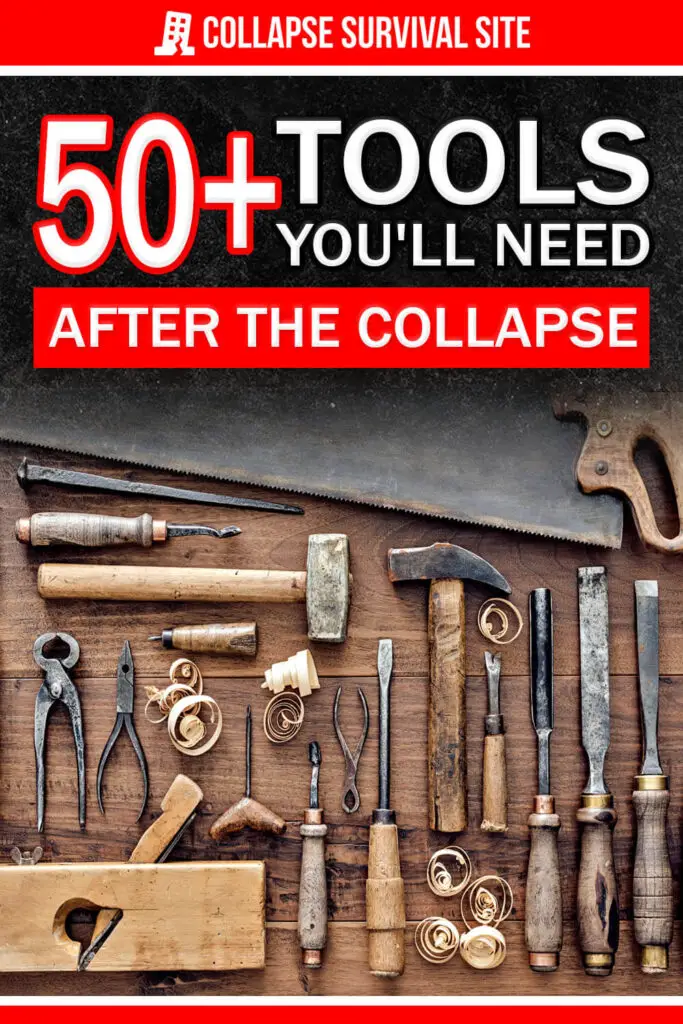Estimated reading time: 10 minutes
The three B’s. Beans, bullets, and band-aids. This has been the motto of preppers for a long time. There is nothing wrong with it as it covers the necessities for survival, food, security, and first aid.
These items are needed for short and long-term survival, but for something more serious, say a total collapse of the system, you must look ahead and beyond the three B’s. One aspect of preparedness that sometimes gets overlooked is that at some point, you are going to have to be able to rebuild and fix stuff, which means you need some tools.
The exercise of this article is to take a look at some of the tools you will need to be self-sufficient after a collapse when there is no supply chain or department store to rely on. To take this a step further, I’ll be focusing on tools that don’t require any electricity or fuel.
Want to save this post for later? Click Here to Pin It On Pinterest!
Tools For After A Collapse
To start, if your plan is to stay within a major metropolitan area after a collapse, then some of these tools probably won’t apply to you. Then again, staying in a large city after a collapse isn’t going to be applicable either.
To try and make things a little easier I will be breaking the tools down into a few different sections. The list of tools I am recommending is by no means a complete list of all the available options but the items I will suggest are basic enough to get you by and the list will give you a baseline to work from to think about other tools you will want or need.
Water Requirements
First things first. You are not going to get very far or get much work done if you don’t have any clean water.
The basic tools required for your water needs include water filters, so that you can filter water, collection containers, transport containers for clean or dirty water, storage containers, a heating source so that you can purify the water through boiling, and a cart for moving all that water where you need it to because one gallon of water weighs just over eight pounds.
Processing Wood
Axe
A good felling axe is sharp and designed for bringing down trees as well as processing trees into more manageable logs.
Maul
Splitting mauls are heavy hitters and are used for splitting larger pieces of wood down into smaller pieces.
Hatchet
Hatchets are compact, and lightweight and are great for small wood processing jobs and clearing trails.
Tomahawk
A true tomahawk is a multitool that can be used for small wood processing tasks, processing game, and self-defense.
Wood Saw
A wood saw can be safer and easier to use than an axe and they give you the ability to make precision cuts. You can use a two-man crosscut saw or a bow saw for smaller logs and branches.
Folding Saw
A folding saw is a compact and lightweight option for when you will be on the move.
Drawknife
A drawknife is a knife with two handles on either side of a blade and this tool helps to remove unwanted material from a piece of wood and in shaping the wood.
Wedges and Sledges
Wedges and sledges can be used to help bring a tree down with preexisting cuts or they can be used to split large logs that are already on the ground.
Gardening
You're probably not going to be worried about what your yard looks like after a collapse in terms of growing roses and having neatly trimmed grass.
But for whatever reason, there may need to be some yard work down, especially if you intend on growing a food garden. Basic tools such as a shovel, leaf rakes, hard rakes, hoe, trowel, pruning shears, or a lopper will help you to get done what you need in the garden and around the yard.
Building, Demolishing, and Fixing
Hammers
You’ll need a good claw hammer for driving nails and removing nails and it can be used for light-duty impact tasks as well. For heavier-duty impact jobs you will need a sledge hammer. For jobs that require some force with a reduced chance of damaging the work surface, use a rubber mallet.
Screwdrivers
You’ll need an array of different types and sizes of screwdrivers for tightening and loosening hardware. Screwdriver sets with fixed shafts are probably the best option as they are the most durable.
However, ratcheting screwdrivers are convenient because they are much more compact and can use a variety of different bits.
Wrenches
Fixed wrenches or adjustable wrenches are used for loosening and tightening hardware, such as bolts and nuts.
Sockets
Sockets are also used for tightening and loosening hardware such as bolts and nuts but can be much quicker to use.
Allen wrenches
Quite a bit of hardware used today requires the use of allen style wrenches.
Precision tools
When working on something that has very small components, a precision screwdriver set, and a hook set will come in handy.
Wood Saw
Wood saws give you the ability to make precision cuts in wood to create the building blocks of your project.
Manual Drill
When building, fixing, or retrofitting something, it’s often the case that you will need to make some holes in the material. A manual drill such as this rotary drill by Stanley or this bit and brace will allow you to drill precision holes without the need for electricity.
Pliers and Channel Locks
Pliers and channel locks provide you with the extra grip you need when tightening, loosening, or just needing to hold onto an object.
Metal Cutters
If you are going to be working with metal at some point, you are going to want a few different types of cutting tools. A hack saw will help you get through pipes, sheets, and hardware. Wire cutters will help you get through small-diameter metal, bolt cutters for larger-diameter metal, and tin snips for softer sheets.
Measuring Tape
A measuring tape will allow you to make quick and accurate measurements.
Square
A square can help you make straight cuts and will help ensure that the material you are working on is properly lined up.
Demo
Prybars, sledgehammers, and wrecking bars are useful for taking things apart and for demolition purposes.
Sharpening Stone
A sharpening stone will help to keep a good edge on your edged tools.
Files
Metal files are used for removing metal and smoothing out a surface. They can be used on project materials or for sharpening your tools. Rasps are similar but they are used on wood.
Clamps and Vice
Clamps are generally small portable tools for holding one or more objects securely in place. A vice does the same job but it is generally more heavy-duty and is fixed in position, like to a workbench.
Chisels
Chisels allow you to shape or remove wood in a precise manner.
Miscellaneous
Plastic sheeting and duct tape have a ton of different uses, especially in performing temporary repairs.
Adhesives such as epoxies, glues, and caulks are consumables but are incredibly useful for sealing and bonding materials together.
Food
While this section doesn’t have anything to do with rebuilding, you are going to need a lot of energy to do that work and that means acquiring food or growing it. A firearm will be the easiest and most used method first for most people but you better have a TON of ammunition stored up or reloading supplies if you intend on using a firearm for a long time.
Hunting
Slingshot
A slingshot is a great tool for hunting because it can use a variety of ammunition, it’s compact and lightweight, and parts of it can easily be improvised should anything break.
Bow
A bow is another useful hunting tool that can be used to acquire food from land, sea, or air. Again, should certain parts break, like the string or arrows, they can be readily improvised. If you are looking for something more compact and “survival” related, check out this bow by SAS
Trapping
Trapping is another energy-efficient way to acquire wild game while you are getting other work done. Live traps are easy to set up and use and snares can easily be made from wire or cordage such as paracord.
Cleaning Knives
Once you have gotten yourself some wild game or fish you will need to be able to clean it and process it. A set of game-cleaning knives will provide you with everything you will need.
Fishing
Fishing is usually an energy-efficient way of getting food. It’s my recommendation that you forget all the fancy gear and gadgets and stick with the basics. All you really need is some simple tackle, and fishing line to catch a fish. But if you would like a rod check out this Telescopic rod or this compact and lightweight handheld Ka-Bar Backpacker Caster
Kitchen
An army marches on its stomach and when you have work to do, you don’t want food preparation to be any more difficult than it needs to be. Kitchens are full of tools but I’m going to focus on a fairly short list of basic items that will help out when it is time to cook!
Cast Iron Cook Set
In my opinion, a lot of modern cookware is junk because it can only be used indoors, it only lasts a few years if you are lucky, or it contains harmful elements. You can avoid all of this by getting yourself some cast iron cookware, which can be used indoors and outdoors and you can hand it down through generations.
Grater
A handheld grater makes short work of processing most types of foods into smaller pieces. A four-sided grater gives you multiple size options and it can help out in preparing a good meal.
Knives
A quality set of knives is worth its weight in gold when it comes to food preparation and they are the foundation of any kitchen.
Sharpening Stone
If you purchase a full knife block set they often come with a sharpener, but if they don’t come with one, be sure to get a sharpening stone to keep those edges honed.
Manual Grain Grinder
A manual grain is a must for anyone growing or storing grain who wants to process that grain later.
Manual Meat Grinder
A manual meat grinder is another grinder that most people should consider getting if they plan on processing and eating a fair amount of meat.
Manual Can Opener
What can I say? Most people store canned goods in their pantries and you are going to need an easy way to get into them. A manual can opener, actually several manual can openers, should be in every kitchen.
Mesh Strainer
Rather than getting a larger, traditional strainer, I prefer these mesh screen types of strainers because they can also be used for sifting and separating certain materials.
Canning Supplies
After all that work of growing your food after the collapse, you might find out that it would be nice to be able to save any excess for a later date. Grab yourself some canning supplies so that not one morsel goes to waste.
Further Research
If you are looking for some more ideas on what simple tools you should have or “old school” ways of making stuff, then I highly suggest checking out videos on YouTube by Townsends.
They concentrate on aspects of 18th century living and they provide a lot of fantastic information on the topic. When watching their techniques keep modern materials in mind that could be substituted. Below I have picked out a few of their videos on the topics of tools and building.
- Making Tools From The Forest – Townsends Wilderness Homestead – Youtube
- Creating a Wooden Mallet on the Frontier – YouTube
- Building Log Cabin Walls – Townsends Homestead Part One – YouTube
- Hand Carving Spoon and Bowl – Our Cabin Needs Utensils – YouTube
- Manual Foot-Powered Vise? – Build A Shavehorse By Hand – YouTube
- Pole Lathe For Our Cabin! – Townsends Wilderness Homestead – YouTube
Like this post? Don't Forget to Pin It On Pinterest!








